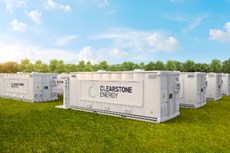Clearstone Energy was an early mover in securing transmission network connections for battery storage and solar projects in the UK and has two 50 MW BESS sites permitted and under construction by Foresight Group. Clearstone Energy’s current BESS pipeline includes eight large scale UK projects with a combined export/import capacity of 2200 MW. All projects have secured transmission network connections and each project occupies an advantageous position within the network to support the complete decarbonisation of the UK electricity supply by 2035.
In 2022, 3.4 TWh of electricity from UK wind farms was lost due to a lack of storage on the electricity grid, equivalent to five days of power for the whole of the UK. Calling up gas-fired power stations to make up for the lost energy cost an estimated £590 million and resulted in 1.3 million t of carbon dioxide emissions.
Clearstone Energy’s battery storage projects occupy strategic positions on the UK transmission network to enable the balancing of supply and demand in an increasingly renewable energy powered UK grid. With projects located close to the connection points for offshore wind farms or in areas of high electricity demand, the portfolio is focused on enabling the UK to transition away from using gas-fired power stations to balance supply and demand across the electricity grid.
“The UK has made tremendous progress with transitioning from fossil fuel electricity generation to large scale wind and solar. Increasing UK battery storage capacity is critical to delivering the clean, affordable and secure UK energy system that the renewable energy transition offers,” said Ben Pratt, Founder of Clearstone Energy. “The battery storage projects we’re developing represent a significant proportion of the storage capacity the UK requires to hit its target of a fully decarbonised UK electricity grid by 2035, and the bigger goal of a net zero UK by 2050.”
The Junction 27 Energy Hub is located on low-grade agricultural land alongside existing road, rail and electrical infrastructure on the M5 corridor in Devon. The South West of England generates more solar energy than any other region of the UK. It is also the furthest point on the transmission network away from offshore wind farms off the east coast of England and Scotland.
The project will provide much needed storage capacity to help balance electricity supply and demand across Devon and Cornwall and reduce reliance on gas-fired power stations. When fully charged the battery would be capable of storing electricity equivalent to six hours of power for all of the 350 000 homes in Devon. It has the potential to displace around 110 000 tpy of carbon dioxide emissions from gas-fired power stations.
The project received broad support from the local community during a public consultation this summer before planning submission. There is significant interest in nature restoration projects within the local community and more than half of the project site for the Junction 27 Energy Hub project has been set aside for initiatives that will enhance nature and wildlife. This includes the creation of wetland habitats and water meadows adjacent to a nearby river.
If consented, the project will deliver a comprehensive community value offering, designed to act as catalyst for the adoption of renewable energy and energy efficiency projects within the local community . This includes financial support to enable low income households to implement energy efficiency, an electricity bill subsidy for local residents and a fund to support community projects focused on nature restoration, energy efficiency and community buildings.
